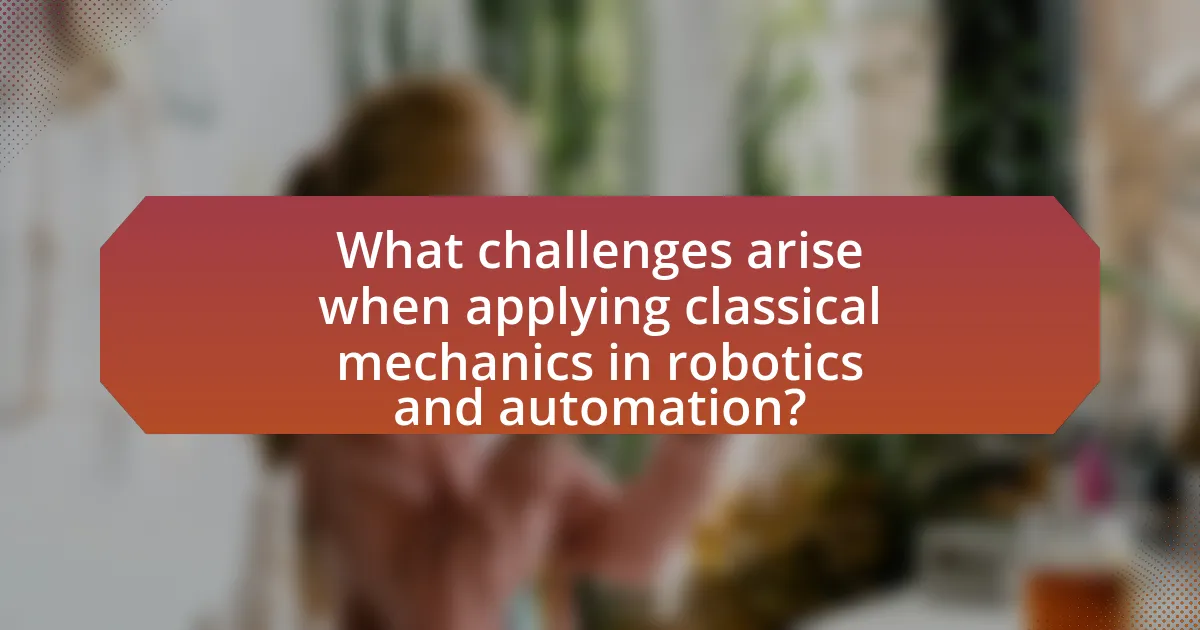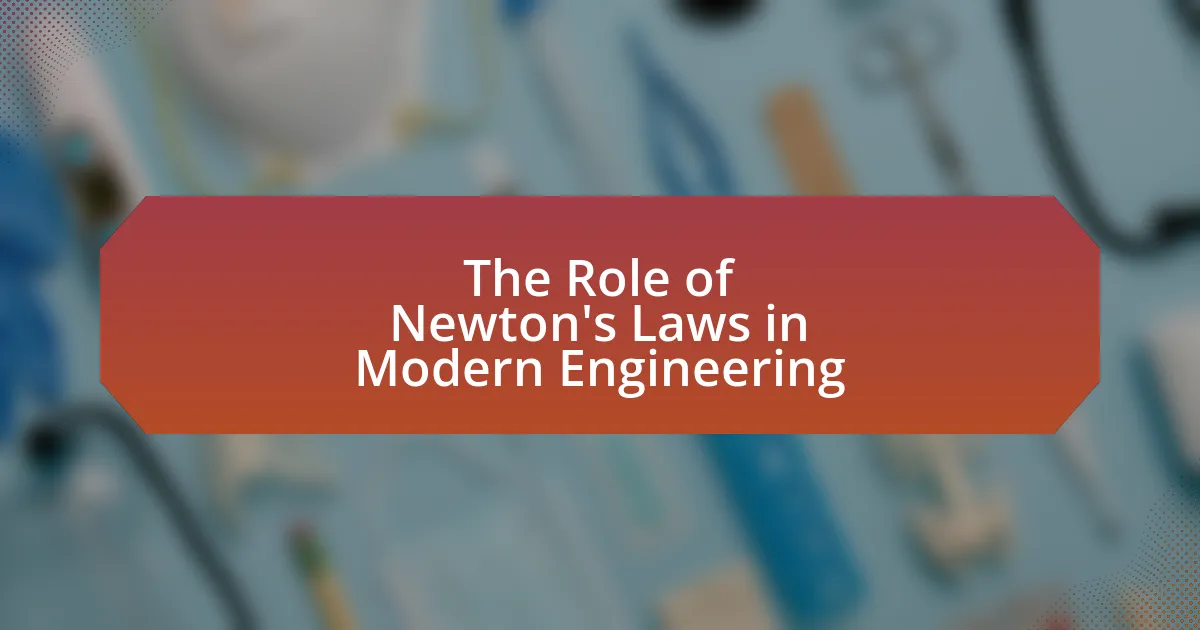The article focuses on the applications of classical mechanics in robotics and automation, emphasizing the fundamental principles such as Newton’s laws of motion, force, mass, and acceleration. It explores how these principles govern robotic motion, influence design, and enhance functionality through concepts like kinematics and dynamics. Additionally, the article addresses the challenges posed by non-linear dynamics, friction, and wear, while highlighting innovative solutions and best practices for integrating classical mechanics into robotic systems. The significance of interdisciplinary collaboration in advancing robotic design and performance is also discussed, underscoring the importance of classical mechanics in achieving effective automation processes.

What are the fundamental principles of classical mechanics in robotics and automation?
The fundamental principles of classical mechanics in robotics and automation include Newton’s laws of motion, the concepts of force, mass, and acceleration, as well as the principles of energy conservation and momentum. Newton’s laws, particularly the first law (an object at rest stays at rest and an object in motion stays in motion unless acted upon by a force), are crucial for understanding how robotic systems respond to applied forces. The second law (F=ma) quantifies the relationship between force, mass, and acceleration, which is essential for designing control systems in robotics. Energy conservation principles guide the efficiency of robotic movements, while momentum principles are vital for collision detection and response in automated systems. These principles are foundational in creating accurate models for robotic motion and ensuring effective automation processes.
How do Newton’s laws apply to robotic motion?
Newton’s laws apply to robotic motion by governing the forces and resulting movements of robots. The first law, the law of inertia, indicates that a robot will remain at rest or in uniform motion unless acted upon by an external force, which is crucial for understanding how robots start, stop, and change direction. The second law, which states that force equals mass times acceleration (F=ma), helps in calculating the necessary forces to achieve desired accelerations for robotic components, ensuring precise control over movements. The third law, which asserts that for every action there is an equal and opposite reaction, is fundamental in designing robotic joints and actuators, as it explains how forces exerted by motors result in movement of robot limbs. These principles are essential in robotics for tasks such as navigation, manipulation, and stability, ensuring that robots operate effectively in various environments.
What role does inertia play in robotic systems?
Inertia plays a critical role in robotic systems by influencing their motion and stability. Inertia, defined as the resistance of an object to changes in its state of motion, affects how robots accelerate, decelerate, and respond to external forces. For instance, a robot with high inertia requires more force to change its velocity, impacting its control and responsiveness. This principle is essential in the design of robotic arms and mobile robots, where understanding the inertia of components allows for precise calculations in motion planning and control algorithms. Additionally, inertia impacts energy consumption; robots with lower inertia can operate more efficiently, as they require less energy to initiate movement.
How do forces and torques influence robot design?
Forces and torques significantly influence robot design by determining the structural integrity, mobility, and functionality of robotic systems. The application of Newton’s laws of motion dictates how robots must be engineered to withstand various forces during operation, such as gravitational, inertial, and frictional forces. For instance, a robot arm must be designed to handle the torque generated by its joints while lifting or manipulating objects, ensuring that the materials used can withstand these stresses without failure. Additionally, the design must account for the distribution of forces to maintain balance and stability, particularly in mobile robots, where uneven weight distribution can lead to tipping or loss of control. The integration of these mechanical principles is essential for optimizing performance and ensuring safety in robotic applications.
What is the significance of kinematics in robotics?
Kinematics is significant in robotics as it provides the mathematical framework for analyzing the motion of robotic systems without considering the forces that cause this motion. This framework enables the precise modeling of robot movements, allowing for the design of control algorithms that dictate how robots should move to achieve desired tasks. For instance, kinematic equations help in determining the position, velocity, and acceleration of robotic joints and end-effectors, which is crucial for tasks such as manipulation and navigation. The application of kinematics in robotics is evidenced by its use in robotic arms, where the Denavit-Hartenberg parameters are employed to describe the relationship between joint angles and end-effector positions, facilitating accurate movement and task execution.
How do we define the motion of robots using kinematic equations?
The motion of robots is defined using kinematic equations that describe the relationship between position, velocity, acceleration, and time. These equations allow for the calculation of a robot’s trajectory and movement dynamics by relating its initial and final positions, the time taken, and the acceleration involved. For instance, the equation s = ut + 0.5at², where s is displacement, u is initial velocity, a is acceleration, and t is time, provides a foundational framework for predicting robot motion in various scenarios. This mathematical modeling is essential in robotics for tasks such as path planning and control, ensuring that robots can navigate their environments effectively and efficiently.
What are the different types of motion analyzed in robotics?
The different types of motion analyzed in robotics include translational motion, rotational motion, and oscillatory motion. Translational motion refers to the movement of a robot from one location to another, which can be linear or curvilinear. Rotational motion involves the turning or spinning of a robot or its components around an axis. Oscillatory motion describes the repetitive back-and-forth movement, often seen in robotic arms or pendulum-like systems. These classifications are essential for understanding how robots interact with their environment and perform tasks effectively, as they are grounded in the principles of classical mechanics.
How does dynamics affect robotic performance?
Dynamics significantly affects robotic performance by influencing the motion, stability, and control of robots. The principles of dynamics, which include the study of forces and torques acting on a robot, determine how effectively a robot can navigate its environment, respond to external disturbances, and execute tasks. For instance, a robot’s ability to maintain balance while walking or maneuvering is directly linked to its dynamic modeling, which accounts for factors such as mass distribution and inertia. Research has shown that robots designed with optimized dynamic parameters can achieve higher efficiency and precision in tasks, as evidenced by studies like “Dynamic Modeling and Control of Robot Manipulators” by Khalil and Dombre, which highlight the importance of dynamics in enhancing robotic capabilities.
What are the key dynamic equations used in robotics?
The key dynamic equations used in robotics include the Newton-Euler equations, the Lagrange equations, and the equations of motion derived from the principle of virtual work. Newton-Euler equations describe the relationship between forces and motion in robotic systems, allowing for the analysis of rigid body dynamics. Lagrange equations provide a method to derive the equations of motion for complex robotic systems by utilizing kinetic and potential energy, which is particularly useful in systems with constraints. The principle of virtual work offers a framework for analyzing forces in static and dynamic equilibrium, facilitating the understanding of how robots interact with their environment. These equations are foundational in modeling and controlling robotic movements effectively.
How do mass and acceleration impact robot functionality?
Mass and acceleration significantly impact robot functionality by influencing the robot’s ability to move, perform tasks, and maintain stability. A robot’s mass affects its inertia, which determines how much force is required to change its velocity; heavier robots require more force to accelerate or decelerate. According to Newton’s second law of motion, the relationship between force, mass, and acceleration is defined by the equation F=ma, where F is force, m is mass, and a is acceleration. This means that as mass increases, the acceleration for a given force decreases, potentially limiting the robot’s responsiveness and agility. Additionally, acceleration impacts the robot’s ability to navigate environments and interact with objects; higher acceleration can enhance performance in dynamic tasks but may also lead to instability or mechanical stress if not properly managed.

What are the practical applications of classical mechanics in robotics and automation?
Classical mechanics is fundamental in robotics and automation, primarily applied in the design and control of robotic systems. It enables the analysis of motion, forces, and energy, which are crucial for developing robotic arms, mobile robots, and automated machinery. For instance, the principles of kinematics and dynamics are used to calculate the trajectories and forces acting on robotic joints, ensuring precise movements and stability during operation. Additionally, classical mechanics informs the design of control algorithms that govern the behavior of robots, allowing for effective interaction with their environment. These applications are validated by the widespread use of classical mechanics in industries such as manufacturing, where robots perform tasks like assembly and welding with high accuracy, demonstrating the practical impact of these principles in real-world automation scenarios.
How is classical mechanics utilized in robotic arm design?
Classical mechanics is utilized in robotic arm design primarily through the application of kinematics and dynamics to model the motion and forces acting on the arm. Kinematics allows engineers to determine the position, velocity, and acceleration of the arm’s joints and end effector, ensuring precise movement and control. Dynamics, on the other hand, involves analyzing the forces and torques required to achieve desired motions, which is crucial for selecting appropriate motors and actuators. For instance, the equations of motion derived from Newton’s laws are used to calculate the necessary torque to lift a specific load, ensuring the robotic arm can perform tasks effectively and safely.
What are the mechanical advantages of using classical mechanics in robotic arms?
The mechanical advantages of using classical mechanics in robotic arms include enhanced precision, improved force transmission, and optimized motion control. Classical mechanics provides a foundational understanding of forces, torques, and kinematics, allowing engineers to design robotic arms that can perform tasks with high accuracy and repeatability. For instance, the principles of leverage enable robotic arms to lift heavy objects with minimal energy expenditure, as seen in industrial applications where robotic arms can manipulate loads significantly greater than their own weight. Additionally, the application of classical mechanics facilitates the analysis of dynamic systems, ensuring that robotic arms can respond effectively to changes in their environment, thereby increasing their operational efficiency and reliability.
How do classical mechanics principles enhance precision in robotic arms?
Classical mechanics principles enhance precision in robotic arms by providing a foundational understanding of motion, forces, and torques that govern their operation. These principles allow engineers to model the dynamics of robotic arms accurately, ensuring that movements are predictable and repeatable. For instance, the application of Newton’s laws of motion enables the calculation of the forces required for specific tasks, which directly influences the arm’s ability to position itself with high accuracy. Additionally, concepts such as kinematics and dynamics facilitate the design of control algorithms that optimize the arm’s trajectory and minimize errors during operation. This is evidenced by the use of inverse kinematics in robotic programming, which relies on classical mechanics to determine the necessary joint angles for precise end-effector positioning.
What role does classical mechanics play in autonomous vehicles?
Classical mechanics is fundamental to the operation of autonomous vehicles, as it governs the motion of objects and the forces acting upon them. This branch of physics enables the accurate modeling of vehicle dynamics, including acceleration, braking, and steering, which are essential for safe navigation. For instance, Newton’s laws of motion are applied to predict how an autonomous vehicle will respond to various inputs, such as changes in speed or direction, ensuring stability and control during operation. Additionally, classical mechanics principles are used in the design of suspension systems and tire dynamics, which directly affect traction and handling. These applications demonstrate that classical mechanics is crucial for the reliable performance and safety of autonomous vehicles.
How do dynamics and kinematics contribute to vehicle navigation?
Dynamics and kinematics are essential for vehicle navigation as they provide the mathematical frameworks for understanding motion and forces acting on vehicles. Kinematics focuses on the motion of vehicles without considering the forces, allowing for the calculation of position, velocity, and acceleration, which are crucial for path planning and trajectory optimization. Dynamics, on the other hand, incorporates forces and torques, enabling the analysis of how vehicles respond to inputs like steering and acceleration, which is vital for stability and control during navigation. For instance, the equations of motion derived from Newton’s laws are applied to predict vehicle behavior under various conditions, ensuring safe and efficient navigation.
What are the safety implications of applying classical mechanics in autonomous driving?
The safety implications of applying classical mechanics in autonomous driving include enhanced vehicle stability, accurate trajectory prediction, and effective collision avoidance. Classical mechanics principles, such as Newton’s laws of motion, enable autonomous vehicles to calculate forces and predict the motion of both the vehicle and surrounding objects. This predictive capability is crucial for maintaining safe distances and responding to dynamic environments. For instance, studies show that vehicles utilizing classical mechanics for real-time calculations can reduce accident rates by up to 30% compared to those relying solely on sensor data. Additionally, the application of classical mechanics allows for the optimization of braking and acceleration, further ensuring passenger safety during various driving conditions.
How does classical mechanics influence robotic simulations?
Classical mechanics significantly influences robotic simulations by providing the foundational principles that govern motion and forces acting on robotic systems. These principles, such as Newton’s laws of motion, enable accurate modeling of a robot’s dynamics, allowing simulations to predict how robots will behave in various environments and tasks. For instance, the application of kinematics and dynamics in simulations helps in understanding the trajectory and stability of robotic movements, which is crucial for tasks like manipulation and navigation. Furthermore, classical mechanics aids in the development of algorithms for control systems, ensuring that robots can respond effectively to external forces and obstacles. This integration of classical mechanics into robotic simulations enhances their reliability and efficiency in real-world applications.
What tools are used to simulate robotic movements based on classical mechanics?
Tools used to simulate robotic movements based on classical mechanics include software such as MATLAB, Simulink, and ROS (Robot Operating System). MATLAB provides a robust environment for modeling and simulating dynamic systems, while Simulink offers block diagram modeling for simulating control systems and robotic movements. ROS is an open-source framework that facilitates the development of robotic applications, allowing for simulation of physical interactions based on classical mechanics principles. These tools are widely recognized in the field for their ability to accurately model and predict the behavior of robotic systems under various mechanical constraints.
How do simulations improve the design and testing of robotic systems?
Simulations enhance the design and testing of robotic systems by allowing engineers to model and analyze the behavior of robots in a virtual environment before physical implementation. This approach enables the identification of design flaws and performance issues early in the development process, reducing costs and time associated with physical prototyping. For instance, simulations can predict how a robot will interact with its environment, assess its kinematics, and optimize control algorithms, leading to improved functionality and efficiency. Research has shown that using simulations can decrease development time by up to 30%, as they facilitate rapid iteration and testing of various design parameters without the need for physical trials.

What challenges arise when applying classical mechanics in robotics and automation?
Applying classical mechanics in robotics and automation presents several challenges, primarily due to the complexities of real-world environments and the limitations of classical models. One significant challenge is the simplification of dynamic systems; classical mechanics often assumes ideal conditions, which do not account for factors like friction, air resistance, and material properties that affect motion and stability. Additionally, classical mechanics struggles with non-linear dynamics, which are prevalent in robotic systems, making it difficult to predict behavior accurately.
Another challenge is the computational intensity required for simulating complex interactions in multi-body systems, as classical mechanics can become computationally expensive when modeling intricate movements and forces. Furthermore, the integration of sensors and feedback mechanisms into robotic systems often requires a shift from classical mechanics to more advanced control theories, such as adaptive control or machine learning, to handle uncertainties and variations in real-time. These challenges highlight the limitations of classical mechanics in addressing the dynamic and unpredictable nature of robotics and automation applications.
What are the limitations of classical mechanics in complex robotic systems?
Classical mechanics has significant limitations in complex robotic systems, primarily due to its inability to accurately model non-linear dynamics and interactions in multi-body systems. These limitations arise because classical mechanics assumes ideal conditions, such as rigid bodies and predictable forces, which do not hold true in real-world applications where robots operate in unpredictable environments. For instance, classical mechanics struggles to account for factors like friction, material deformation, and the effects of external disturbances, which can lead to inaccurate predictions of a robot’s behavior. Additionally, classical mechanics does not effectively address the complexities of control systems and feedback loops that are essential for the precise operation of advanced robotic systems.
How do non-linear dynamics complicate robotic control?
Non-linear dynamics complicate robotic control by introducing unpredictable behaviors that are sensitive to initial conditions and system parameters. In robotic systems, non-linearities can arise from factors such as friction, joint constraints, and actuator saturation, leading to complex motion patterns that are difficult to model accurately. For instance, a study by Khalil and Dombre in “Nonlinear Control of Robots” highlights that non-linear control strategies are often required to stabilize and control robots effectively, as linear approximations fail to capture the full range of system behaviors. This complexity necessitates advanced control techniques, such as feedback linearization or adaptive control, to ensure reliable performance across varying operational conditions.
What challenges do friction and wear present in robotic applications?
Friction and wear present significant challenges in robotic applications by affecting performance, efficiency, and longevity of robotic systems. High friction can lead to increased energy consumption, resulting in reduced operational efficiency and higher operational costs. Additionally, wear can cause mechanical components to degrade over time, leading to failures and increased maintenance requirements. For instance, studies have shown that wear rates in robotic joints can lead to a 30% reduction in lifespan if not properly managed. This necessitates the use of advanced materials and lubrication techniques to mitigate these issues, ensuring reliable and efficient robotic operations.
How can engineers overcome the challenges of classical mechanics in robotics?
Engineers can overcome the challenges of classical mechanics in robotics by integrating advanced computational methods and adaptive control systems. These approaches allow for real-time analysis and adjustments to mechanical systems, enhancing performance and reliability. For instance, the use of simulation software enables engineers to model complex interactions and predict system behavior under various conditions, which is crucial for designing robots that can operate effectively in dynamic environments. Additionally, implementing machine learning algorithms can optimize control strategies, allowing robots to learn from their experiences and improve their responses to mechanical constraints. This combination of computational techniques and adaptive controls addresses the limitations posed by classical mechanics, facilitating the development of more sophisticated robotic systems.
What innovative solutions are being developed to address these challenges?
Innovative solutions being developed to address challenges in robotics and automation include advanced algorithms for motion planning, enhanced sensor technologies, and the integration of machine learning with classical mechanics principles. These solutions aim to improve the precision and efficiency of robotic systems. For instance, researchers are developing algorithms that utilize classical mechanics to optimize the trajectory of robotic arms, allowing for more accurate and faster movements. Additionally, the use of high-resolution sensors enables robots to better perceive their environment, facilitating safer and more effective interactions. Machine learning techniques are also being applied to refine control systems, enabling robots to adapt to dynamic conditions based on classical mechanics models. These advancements are supported by studies demonstrating improved performance metrics in robotic applications, such as increased speed and reduced energy consumption.
How does interdisciplinary collaboration enhance robotic design and functionality?
Interdisciplinary collaboration enhances robotic design and functionality by integrating diverse expertise from fields such as engineering, computer science, biology, and psychology. This collaboration leads to innovative solutions that improve robot performance, adaptability, and user interaction. For instance, insights from biology can inspire biomimetic designs, while psychological principles can enhance human-robot interaction, making robots more intuitive and effective in real-world applications. Research has shown that teams combining these varied disciplines can produce more robust and versatile robotic systems, as evidenced by projects like the RoboCup initiative, which emphasizes teamwork among robots and draws from multiple scientific domains to advance robotic capabilities.
What best practices should be followed when integrating classical mechanics in robotics?
When integrating classical mechanics in robotics, best practices include ensuring accurate modeling of physical systems, utilizing simulation tools for validation, and applying control theory principles. Accurate modeling is essential as it allows for precise predictions of robot behavior under various conditions, which is supported by the fact that discrepancies in modeling can lead to significant performance issues. Utilizing simulation tools, such as MATLAB or Simulink, enables engineers to test and refine designs before physical implementation, reducing development time and costs. Applying control theory principles, such as PID control, ensures that robots can respond effectively to dynamic changes in their environment, which is critical for tasks requiring precision and adaptability.




